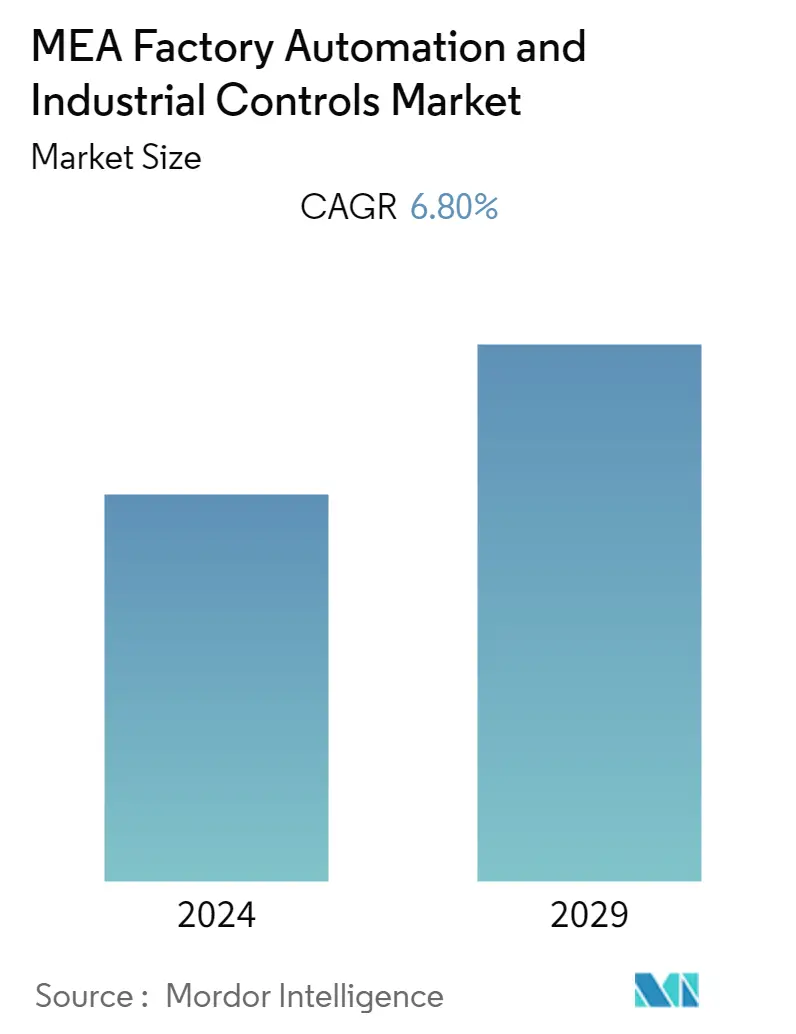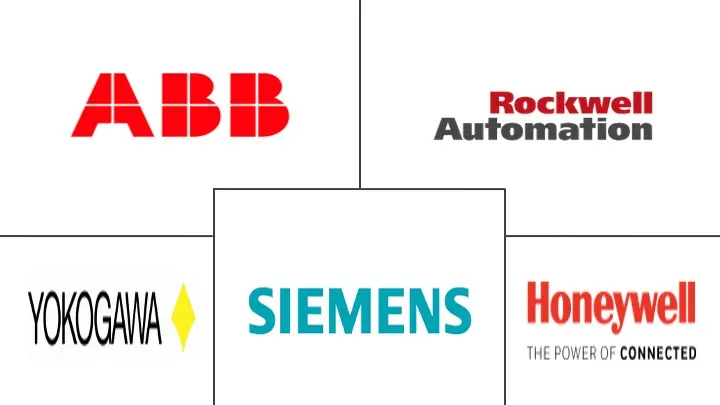Market Size of MEA Factory Automation and Industrial Controls Industry

| Study Period | 2019 - 2029 |
| Base Year For Estimation | 2023 |
| Forecast Data Period | 2024 - 2029 |
| Historical Data Period | 2019 - 2022 |
| CAGR | 6.80 % |
| Market Concentration | Medium |
Major Players
*Disclaimer: Major Players sorted in no particular order |
MEA Factory Automation & Industrial Controls Market Analysis
The Middle East and Africa Factory Automation and Industrial Controls Market is expected to register a CAGR of approximately 6.8% during the forecast period (2021 - 2026). The COVID-19 pandemic and lockdown restrictions across the region have affected industrial activities including disruption of supply chain. However, the pandemic has forced manufacturing industries to re-evaluate their traditional production processes and adapt to smart manufacturing practices across the production lines.
- Following the global economic recession led by COVID-19, the Middle Eastern and African factory automation and industrial control system market has witnessed positive impact from the demand side and mixed impact from the supply side in the first half of 2020. Smart factory initiatives have helped manufacturers overcome COVID-19 challenges and address issues such as workforce reductions, drops in sales for some specific products, social distancing, and extreme pressure to cut operational costs since most enterprises operating in the end-user industries (majorly manufacturing, automotive) had shuttered down their production sites due to lockdown restrictions.
- The GCC is eyeing a new manufacturing era based on modern industrial society. The increasing active collaborations between government, regulators, and organizations for economic development is one of the major factors driving growth in the region's automation and manufacturing sectors.
- The market in these countries is majorly driven by increasing investments in the oil and gas industry. The progress in the oil and gas sector is translating into other industries and notably energy solutions. For instance, in October 2019, the Nigerian government partnered with the Government of Norway to work out measures that will help in the expansion of Nigeria's power sector.
- Saudi Arabia initiated USD 7 billion of renewable energy projects in 2018, with solar plants being the frontrunner. It is part of its plan to install 9.5 gigawatts of solar and wind capacity by 2023. such infrastructural developments are likely to provide for industrial controls and factory automation solutions.
MEA Factory Automation & Industrial Controls Industry Segmentation
The study characterizes the market, based on the type of products, such as SCADA, DCS, PLC, robotics, VFDs, and motors, among others. By end-user industry, the market is divided by oil and gas, chemical and petrochemical, automotive, and food and beverage, among others.
The syndicated study on factory automation and industrial controls (or industrial automation) includes both process and discrete automation. The scope is comprehensive and is limited to Middle East and Africa.
| Type | |||||||||
| |||||||||
|
| End-user Industry | |
| Oil and Gas | |
| Chemical and Petrochemical | |
| Power and Utilities | |
| Food and Beverages | |
| Automotive and Transportation | |
| Other End-user Industries |
| Country | |
| United Arab Emirates | |
| Saudi Arabia | |
| South Africa | |
| Rest of Middle East and Africa |
MEA Factory Automation and Industrial Controls Market Size Summary
The Middle East and Africa factory automation and industrial controls market is poised for significant growth, driven by the region's shift towards smart manufacturing practices. The COVID-19 pandemic acted as a catalyst, prompting industries to reassess traditional production methods and embrace automation to enhance efficiency and reduce operational costs. The market is primarily fueled by investments in the oil and gas sector, which is increasingly adopting industrial control systems to ensure safety, reliability, and efficiency. This trend is supported by the integration of advanced technologies such as Big Data and the Internet of Things, which are expected to unlock new opportunities for market players. The Gulf Cooperation Council (GCC) countries, particularly Saudi Arabia, are at the forefront of this transformation, with substantial government investments in renewable energy projects and infrastructure development, such as the NEOM city, which are set to bolster the demand for automation solutions.
Saudi Arabia is anticipated to lead the factory automation and industrial controls market in the region, driven by its Vision 2030 initiative and significant investments in new technologies. The country's focus on Industry 4.0 and advanced manufacturing is indicative of its readiness to adopt innovative solutions to enhance production quality and output. The market landscape is moderately fragmented, with key players engaging in strategic partnerships and product development to strengthen their market presence. Notable developments include COPA-DATA's establishment of a branch office in Saudi Arabia to enhance market coverage and Rockwell Automation's introduction of cloud-based solutions to facilitate digital transformation. These initiatives, along with collaborations aimed at improving cybersecurity and optimizing plant performance, underscore the dynamic nature of the market and its potential for growth over the forecast period.
MEA Factory Automation and Industrial Controls Market Size - Table of Contents
-
1. MARKET DYNAMICS
-
1.1 Market Overview
-
1.2 Industry Value Chain Analysis
-
1.3 Industry Attractiveness - Porter's Five Forces Analysis
-
1.3.1 Bargaining Power of Suppliers
-
1.3.2 Bargaining Power of Consumers
-
1.3.3 Threat of New Entrants
-
1.3.4 Threat of Substitutes
-
1.3.5 Intensity of Competitive Rivalry
-
-
1.4 Market Drivers
-
1.4.1 Demand for Fast Production Capacity Creates Need for Rampant Industrial Automation
-
1.4.2 Rising Incidences of Cyberattacks
-
-
1.5 Market Challenges
-
1.5.1 Lack of Awareness Regarding Automation
-
1.5.2 Complexity in Implementing Security Systems
-
-
1.6 Assessment of Impact of COVID-19 on the Industry
-
-
2. MARKET SEGMENTATION
-
2.1 Type
-
2.1.1 Industrial Control Systems
-
2.1.1.1 Distributed Control System (DCS)
-
2.1.1.2 Programmable Logic Controller (PLC)
-
2.1.1.3 Supervisory Control and Data Acquisition (SCADA)
-
2.1.1.4 Product Lifecycle Management (PLM)
-
2.1.1.5 Manufacturing Execution System (MES)
-
2.1.1.6 Human Machine Interface (HMI)
-
2.1.1.7 Other Industrial Control Systems
-
-
2.1.2 Field Devices
-
2.1.2.1 Machine Vision Systems
-
2.1.2.2 Industrial Robotic
-
2.1.2.3 Motors and Drives
-
2.1.2.4 Safety Systems
-
2.1.2.5 Sensors and Transmitters
-
2.1.2.6 Other Field Devices
-
-
-
2.2 End-user Industry
-
2.2.1 Oil and Gas
-
2.2.2 Chemical and Petrochemical
-
2.2.3 Power and Utilities
-
2.2.4 Food and Beverages
-
2.2.5 Automotive and Transportation
-
2.2.6 Other End-user Industries
-
-
2.3 Country
-
2.3.1 United Arab Emirates
-
2.3.2 Saudi Arabia
-
2.3.3 South Africa
-
2.3.4 Rest of Middle East and Africa
-
-
MEA Factory Automation and Industrial Controls Market Size FAQs
What is the current MEA Factory Automation and Industrial Controls Market size?
The MEA Factory Automation and Industrial Controls Market is projected to register a CAGR of 6.80% during the forecast period (2024-2029)
Who are the key players in MEA Factory Automation and Industrial Controls Market?
Siemens AG , Yokogawa Electric Corporation , Rockwell Automation Inc. , ABB Limited and Honeywell International Inc. are the major companies operating in the MEA Factory Automation and Industrial Controls Market.

